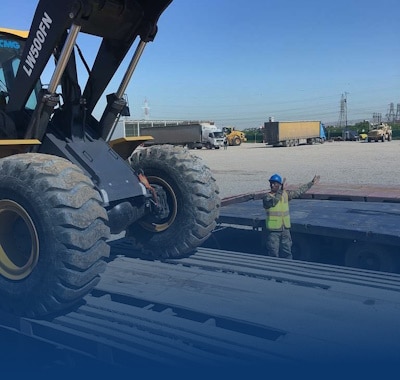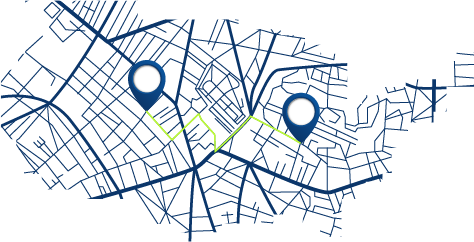Heavy Haul Delays from I-10 Construction Across the South
Freedom Heavy Haul can offer expedited Pickup and Delivery for any size shipment anywhere in the USA. Contact us today for No Hassle, No Pressure Pricing.
Quick update: This guide pulls timely news and routing essentials for carriers facing route impacts. Baton Rouge work now extends toward 2031, and DOTD lists risks like supply chain issues or severe weather that could change the schedule.
Next visible work is the westbound flyover at the I-110 split, a downtown pinch point that will shape traffic and staging. In San Antonio, TxDOT set a full weekend closure of Loop 1604 main lanes at the I-10 interchange for April 26–29.
DOTD corridor upgrades add a fourth lane each way and modernize interchanges while generally keeping travel lanes during Segment 1. Expect intermittent ramp changes, lane shifts, and short-term closures that affect oversized moves and convoy timing.
Use this piece as a fast-access update for closures, detours, and live feeds. We flag likely staging spots, permit tips, and where to check maps before you roll to cut traffic risk and keep freight on schedule this year.
Service directory overview for carriers moving oversize loads
Start here: this compact directory links each department transportation office to permitting portals and live traveler feeds so dispatchers can check routes fast. Use the list before any move to confirm permits and escalation contacts.
We show how current project phases affect available lanes and lane widths on nearby interstate segments. That detail helps you pick safe staging near ramps and frontage roads and avoid tight lane and shoulder constraints.
State rules on escorts, curfews, and holiday windows are summarized for quick reference. When night or weekend travel needs special approvals, the directory points to the right agency contact.
Routing notes flag which downtown approaches and interchange ramps restrict height, width, or turning radius. Our quick links make checking closures and live traffic status a minute-long task.
- Escalation paths inside each agency for multi-segment permits.
- Staging tips tied to axle configurations and preferred lane position.
- Callouts for interchanges that commonly trigger slowdowns.
Heavy haul delays from I-10 construction across the South
Active work zones near major interchanges are already changing how carriers stage and time oversize moves. Plan with extra buffer time and daily checks to avoid surprises.
What “present” conditions mean for route planning today
Rolling closures and lane shifts are common. In baton rouge, Segment 1 runs to 2031 while DOTD preserves travel lane counts but compresses shoulders and shifts alignments.
This setup affects wide loads, pilot placement, and permit windows. Blend live traffic feeds with agency alerts to keep drivers legal and moving.
Key hotspots: Baton Rouge I-10/I-110 and San Antonio I-10/Loop 1604
Downtown approaches at the I-110 split can slow moves and complicate staging. San Antonio has scheduled full weekend closures of Loop 1604 main lanes at the interchange (example: April 26–29).
- Baton Rouge: compressed lanes and ramp shifts; consider alternate downtown bypasses.
- San Antonio: weekend closures can block passage; confirm permit windows before rollout.
- Always run a morning-of check for added closures or incident stacking.
| Location | Primary impact | Recommended action |
|---|---|---|
| Baton Rouge (Segment 1) | Compressed shoulders, intermittent ramp closures | Plan wider buffers; use alternate downtown staging |
| San Antonio (Loop 1604) | Full weekend closures at interchange | Confirm permit flexibility; shift to weekday windows |
| Both corridors | Unpredictable lane shifts and slowed traffic | Share present-condition summaries in pre-trip calls |
Current traffic alerts and lane closures impacting oversize/overweight moves
Current movement windows and posted work notices are reshaping which routes remain viable for oversize moves this week. Check agency feeds before departure and share the latest status with drivers and customers.
Full weekend closure: Loop 1604 main lanes at the I-10 interchange (TX)
TxDOT has a full weekend closure of Loop 1604 eastbound and westbound main lanes at the interchange from Friday 9 p.m. to Monday 5 a.m. (April 26–29).
Plan staging before Friday evening so equipment is not trapped inside work limits. Use live traffic feeds to time arrivals just after the closure lifts to reduce idle time near the interchange.
Intermittent ramp closures and lane shifts announced by DOTD (LA)
Louisiana DOTD will preserve travel lane counts on Segment 1 while using intermittent ramp closures and lane shifts. Notices publish via the DOTD website, apps, and media.
- Validate detours for your dimensions; some signed detours are unsafe for extreme width or height.
- Confirm pilot car availability if a planned ramp is under a temporary hold.
- Build extra time into Hours-of-Service planning when ramp access forces longer surface connections.
| Alert | Impact | Action |
|---|---|---|
| Loop 1604 weekend closure (TX) | Main lanes closed Fri 9pm–Mon 5am | Stage early; use alternate weekday windows; verify detours |
| DOTD Segment 1 | Intermittent ramp closures, lane shifts | Check DOTD app before roll; plan pilot car and detour options |
| General traffic notices | Last-minute extensions possible during active work | Monitor feeds; inform customers early in the week |
Baton Rouge I-10 widening: timeline, segments, and 2031 completion target
Segment 1 centers on the City Park Lake approaches and the stretch to I-110, where staging and lane fits will matter most.
Segment 1: Acadian Thruway to I-110 downtown corridor
Work began in February 2023 and DOTD expects this phase to continue through 2031. Segment 1 focuses on downtown upgrades, bridge approaches, and interchange modernizations.
Lane preservation during construction and expected shifts
DOTD will keep current travel lanes open, while adding a fourth lane in each direction across the corridor. Shoulder widths, merge tapers, and lane geometry may change near bridge spans and lake crossings.
- Expect constrained shoulders and periodic lane shifts near Acadian and Perkins exits.
- Targeted ramp closures and short-term lane changes will appear as crews adjust staging.
Property acquisition status and project schedule implications
WAFB reports 22 properties still need acquisition. DOTD officials say 2031 is attainable unless major disruptions occur.
“2031 is attainable barring major disruptions,” — DOTD spokesperson Rodney Mallett
| Item | Impact | Recommended action |
|---|---|---|
| Segment 1 timeline | Through 2031; phased work | Plan moves around known work windows |
| Lane and shoulder changes | Vary near bridge and lake crossings | Verify lane widths before routing |
| Property acquisitions | Active near Perkins; may alter staging | Monitor announcements; adjust permits |
Louisiana DOTD resources and contacts for routing and updates
Dispatchers should rely on DOTD apps and project pages for the fastest routing alerts and official notices. Use those channels first for verified information on lane shifts, intermittent ramp closures, and staging that affect downtown approaches and interchange nodes.
Project pages, apps, and media alerts for the I-10/I-12 corridor
The DOTD project page lists status updates, downloadable detour maps, and lane shift diagrams. Save the Learn More and College Flyover links for design-build sequencing that may change traffic flow.
Install the DOTD mobile app and subscribe to media alerts so dispatch gets early notice of overnight work. That helps you pre-brief drivers and pilot cars before roll time.
How to submit comments and get official notices
Use the Submit Comment link to flag detours that conflict with OS/OW constraints. Keep a record of submissions to track agency responses and refine routing assumptions.
Maintain a direct line to DOTD officials for time-sensitive questions about route adjustments. Add contact names and escalation steps to your SOPs so permit clarifications move quickly.
- Review downloadable maps and lane diagrams before each move.
- Confirm how updates are pushed (email/SMS) to avoid missed notices.
- Align internal checks so DOTD notices are verified before finalizing move times.
| Resource | Use | Action |
|---|---|---|
| DOTD project page | Official updates, maps | Bookmark and check daily |
| DOTD app & media alerts | Real-time notices | Subscribe; enable notifications |
| Submit Comment | Stakeholder feedback | Record submissions; escalate if urgent |
Texas I-10 and Loop 1604 interchange: closures, detours, and timing
Expect major weekend routing changes near Loop 1604 that require confirmed detours and early staging. TxDOT has a full closure of Loop 1604 eastbound and westbound main lanes at the interchange from Friday 9 p.m. to Monday 5 a.m. (April 26–29). Plan around that window to avoid being trapped inside work limits.
Weekend closure window and staging considerations
Pre-stage on the correct side of the closure before Friday evening to cut deadhead mileage and lost time. Confirm pilot car availability for Monday restarts when traffic rebounds quickly.
- Build detours that accommodate oversize height and width and verify with TxDOT resources.
- Align driver HOS so parked time during the weekend does not burn critical on-duty hours.
- Check ramp availability near staging to prevent backtracking once lanes reopen.
- Consider alternate corridors if permits or local surface streets won’t accept your load.
- Communicate mid-week with customers to lock in pickups and deliveries around this closure.
| Item | Impact | Recommended action |
|---|---|---|
| Loop 1604 weekend closure | Main lanes closed Fri 9pm–Mon 5am | Pre-stage; verify detours with department transportation; confirm pilot cars |
| Ramp and surface detours | Alternate routing may be needed for wide/overheight loads | Validate detour clearance; get written confirmation when possible |
| Restart traffic surge | Early Monday congestion near interchange | Stagger rollouts; brief drivers on restart timing |
| Adjacent projects | Stacked impacts near NW Side | Review local project notices; capture lessons for next week |
Lane, ramp, and flyover specifics heavy haulers need to know
Plan for altered merge geometry and tighter approaches near downtown. DOTD indicates the next visible phase will expand the i-10 westbound flyover at the I-110 split. That work will change merge zones that matter for escort spacing and convoy timing.
I-10 westbound flyover expansion at the I-110 split (Baton Rouge)
Expect temporary ramp shifts and approach changes. Verify clearances and widths before committing an oversize convoy.
Bridge approaches near the split can develop tighter radii during work. Pre-run the route virtually and, if possible, conduct a pilot-car pass to confirm turning geometry.
College Flyover Ramp: separate design-build contract notes
The College Flyover Ramp is managed under a separate design-build contract (State Project No. H.013897). Timelines and staging may not match corridor sequencing, so confirm that project’s notices independently.
- Anticipate night operations with bright lighting; brief drivers on speed and lane placement.
- Ramp signage may change often; use updated agency maps and truck nav overlays.
- Coordinate law-enforcement escorts and set remote crane/escort rendezvous points for long, multi-axle moves.
| Item | Impact | Recommended action |
|---|---|---|
| i-10 westbound flyover expansion | Altered merge zones and temporary ramp shifts | Verify escort spacing; confirm lane widths before rollout |
| Bridge approaches at split | Tighter turning radii during work | Pre-run route; use pilot car for verification |
| College Flyover Ramp (H.013897) | Separate schedule and staging | Monitor that project page independently; adjust permits |
| Night operations & signage changes | Lighting glare and frequent sign updates | Coach drivers; refresh maps daily; coordinate escorts |
State-by-state service directory: Louisiana
Start your Louisiana routing check with local permit windows and staged access near downtown Baton Rouge. Secure oversize permits early and confirm curfew rules that can tighten movement windows during events.
Permits, escorts, and curfew windows near downtown and Perkins Road
Book Louisiana oversize permits well before planned moves. Curfews and municipal events often limit daytime windows near downtown.
Plan escorts for narrow ramps and tight turning at Perkins Road. Coordinate pilot cars and law-enforcement escorts to handle complex turns.
Bridge, interchange, and City Park Lake trestle work zones
DOTD has built a temporary trestle bridge across City Park Lake near Dalrymple Drive to support Segment 1 work. Expect shoulder reductions and altered approach geometry around that trestle.
Monitor lane closures and bridge work diagrams from the louisiana department transportation to avoid unexpected restrictions.
Preferred staging areas and local access to I-10 westbound and eastbound
Pick staging lots that can accept long combinations and let drivers re-enter mainline traffic safely. Preselect exits with wide turning radii and low pedestrian activity.
Confirm day-of staging and any flyover ramp activity before dispatch; separate flyover projects can overlap mainline work and affect ramp availability.
- Tip: Coordinate with louisiana department contacts for late changes to ramp access and detour viability.
- Note: Property acquisition work near Perkins Road may temporarily limit local access—adjust routes accordingly.
- Action: Use agency maps to avoid low-clearance or weight-restricted city streets when skirting downtown.
| Item | Recommended action | Why it matters |
|---|---|---|
| Permits & curfews | Secure early; confirm event schedules | Prevents rejected moves and lost time |
| City Park Lake trestle | Verify shoulder and lane widths | Supports safe escort spacing and clearances |
| Staging & exits | Preselect exits with generous turning space | Makes re-entry safer for eastbound and westbound access |
State-by-state service directory: Texas
Quick check: treat TxDOT detour maps as live documents and re-validate them before each rollout. Use the department transportation calendar for confirmed windows and to avoid surprises around major interchange work.
TxDOT closure calendars and detour maps near the I-10 interchange
TxDOT posts full weekend closures of Loop 1604 main lanes at the interchange (example: April 26–29). Check those calendars early in planning so you can choose interstate-friendly detours with safe parking.
- Confirm closures and map timestamps before staging.
- Validate detour clearances for width, height, and turning radii at frontage roads and ramps.
- Expect changing lane and shoulder layouts near active project zones; recheck the map just prior to roll.
OS/OW permitting checkpoints and overnight movements
Verify whether your permit allows overnight movement and if local police escorts are required. Time-stamped approvals from the department transportation office reduce hold-ups during closures.
- Check that lanes interstate and shoulders meet your load’s needs.
- Monitor traffic speeds to place moves in lower-congestion windows.
- Watch flyover and ramp markings at night; temporary signs may shift as crews stage.
| Item | Impact | Recommended action |
|---|---|---|
| Weekend closures | Main lanes closed; staging limits | Pre-stage outside work limits; confirm escort rules |
| Lane closures & ramp shifts | Reduced shoulder and changing geometry | Verify lane widths; run a pilot-car pass if needed |
| Detour maps | Alternate routes with mixed services | Pick interstate-friendly detours and check parking |
Detour planning for oversize loads near I-10 work zones
Plan detours that steer oversized moves away from tight downtown corridors and known event routes. Early routing choices cut risk and save time when lanes shift or short closures appear.
Alternatives around downtown Baton Rouge and the Mississippi River crossings
Avoid core downtown by routing to outer frontage roads or parallel state routes that offer wider turning radii. Map alternates that bypass fast-changing work zones and event traffic.
For Mississippi River crossings, verify bridge weight limits and escort rules before you commit tall or wide loads. If a bridge has restrictions, pick a crossing with documented clearances and known escort availability.
San Antonio NW Side routing during Loop 1604 main lane closures
When Loop 1604 main lanes close, use NW Side detours that reduce acute turns and low clearances. Favor routes with long turn pockets and clear signal timing for long combinations.
Stage on the interchange side that matches your next-day heading to cut deadhead miles. Coordinate with local escorts who know downtown rules and peak work-hour timing.
- Delay re-entry to the mainline until you are clear of stacked work near the I-10/I-110 interchange when needed.
- Validate temporary signal timing and turn pocket lengths on surface detours.
- Build at least one recovery option in case an incident extends a scheduled closure and notify customers with updated ETAs.
| Scenario | Primary risk | Recommended detour |
|---|---|---|
| Downtown Baton Rouge moves | Tight turns; reduced shoulders | Use outer frontage or state routes with wide ramps |
| Mississippi River crossing | Bridge weight/height limits | Choose confirmed bridge with escort approval; verify paperwork |
| Loop 1604 weekend closure | Low-clearance structures on surface detours | Pick NW Side routes with long turn pockets; pre-stage accordingly |
| Stacked work near interchange | Entry blocked or rerouted | Delay re-entry until beyond work zone; stage strategically |
Permits, escorts, and coordination with transportation departments
Start permit planning early to match agency posting cycles and avoid last-minute rejections. Align requests with known work windows so your move won’t conflict with posted closures or temporary ramp shifts.
Louisiana Department of Transportation and Development guidance matters for escorts, curfews, and downtown limits. Review lane-width and shoulder notes before filing. Attach a brief detour impact assessment to each application to show safe routing and turning geometry.
TxDOT OS/OW procedures during active work windows
Coordinate with TxDOT when weekend closures force after-hours or alternate timing. Confirm whether a permit allows night moves and whether police escorts are required. Get time-stamped approvals so drivers can present clear authorization if stopped near an interchange.
Contacting officials for after-hours movement approvals
Maintain an up-to-date list of agency contacts and escalation paths. Document calls and emails and add copies to permit files. When an interchange approach is blocked, include that record with your revised routing and request multi-day validity if weather or other issues may push your schedule.
“Attach detour impact assessments and confirm multi-day spans to reduce risk of rejected moves.”
- Tie project schedules to agency posting cycles to catch late restrictions.
- Confirm escorts and curfew windows with louisiana department transportation before finalizing staging.
- For multi-state moves, synchronize permit timing to pass consecutive work zones without idle time.
| Action | Why it matters | Suggested step |
|---|---|---|
| Attach detour assessment | Shows safe routing and clearances | Include maps and turn radii notes |
| List of officials | Speeds clarification on permits | Keep names, numbers, escalation steps |
| Multi-day validity | Covers weather or schedule slips | Ask agencies for extended spans |
Weather, work windows, and schedule variability
When storms hit or materials run late, project milestones can slide and routing plans must adapt quickly.
What to expect: DOTD warns that a global pandemic, extended supply chain issues, or a severe hurricane season could shift the 2031 completion target for Segment 1. That means permit windows and daily work windows may move on short notice.
Severe weather can shut down crews and extend a temporary closure near an interchange or bridge. Plan recovery time and expect slower clearing of traffic after major events.
- Build buffer days into OS/OW plans during peak storm seasons.
- Prepare alternate routes that avoid flood-prone low points and vulnerable bridge approaches.
- Reconfirm pilot car and escort availability when forecasts force same-day changes.
Operational tips: Coordinate with agencies for real-time guidance as forecast risks rise. Give drivers clear shelter-in-place and reroute instructions, and update customers often so ETAs match the latest notices.
| Risk | Likely effect | Recommended action |
|---|---|---|
| Severe weather | Work pauses; extended closures | Build buffer days; pre-stage outside work limits |
| Supply chain issues | Milestone shifts into next year | Adjust long-range plans; ask agencies for flexible permits |
| Storm impact on bridge/trestle | Safety-driven lane or ramp closure | Use alternate crossings; verify clearances and escorts |
Carrier compliance checklist for lane closures and ramp restrictions
Confirm critical limits before you roll. Start by verifying active lane closures along your route and confirm acceptable lane widths for your permitted dimensions. This reduces risk and helps drivers follow permit terms.
Check ramp access and signage. Confirm ramp accessibility and whether temporary signs change approach angles for long-wheelbase equipment. Note any short-radius turns that need pilot verification.
- Cross-check interchange restrictions posted by the department transportation before finalizing schedules.
- Validate pilot car and escort requirements for each segment affected by active work and construction.
- Ensure drivers carry current permits and know who to contact if a closure blocks planned access.
- Preload turn-by-turns to avoid last-second merges in narrowed lanes.
- Assign a dispatcher to monitor live closure feeds during critical move windows.
- Document detour-driven changes to axle spacing or turning plans.
- Train drivers on cone and barrier patterns common in work zones to prevent encroachment.
- Keep PPE and safety protocols current for any required on-foot checks near staging areas.
Shipper-carrier communication playbook during I-10 expansion work
Good communication turns a last‑minute reroute into a manageable schedule change for both shipper and carrier. Use clear protocols that keep customers informed and operations steady when interchange approaches or lane patterns change.
ETAs, re-routing, and live updates:
Set expectations and update cadence
Send proactive ETA windows that account for known work-zone slowdowns near critical interchanges. Share three touchpoints: pre-departure, mid-route, and a post-closure confirmation.
Use simple media to explain changes
Record short video clips or annotated maps to show why a route shifted. Visuals help dock crews and brokers see the issue fast and approve alternate slots.
Reference officials and project milestones
When customers ask for proof, cite verified statements and project timelines from officials. Attach a brief excerpt or link so receivers trust revised ETAs.
- Push live traffic snapshots during transit so receivers can stage labor and cranes.
- Keep a library of customer-ready notices for common closure scenarios.
- Offer alternate delivery windows if staging overnight is required.
- Coordinate messages with brokers so everyone has the same plan.
- Log post-move debrief notes to refine scripts and routing next time.
“Clear, timely updates reduce idle time and keep operations aligned across teams.”
| Action | Why it helps | Timing |
|---|---|---|
| Pre-departure ETA | Sets customer expectations | Before roll |
| Mid-route traffic snapshot | Allows dock planning | During transit |
| Post-closure confirmation | Closes the loop and records changes | After move completes |
Mapping tools and live data sources to navigate I-10 delays
Real-time maps and layered feeds give dispatchers an edge when lane patterns and ramp access shift rapidly. Use official apps and telematics overlays together to spot closures, altered merge zones, and serviceable exits before you commit to a route.
DOTD apps, TxDOT feeds, and third-party telematics overlays
Layer agency feeds into your fleet platform so closures and lane shifts appear on your dashboard in near real-time. DOTD’s mobile app and project site publish intermittent ramp notices and lane updates. TxDOT posts confirmed weekend closure windows for Loop 1604 at the interchange.
- Use lanes interstate overlays to see width limits vs. your load and flag unsafe corridors.
- Tag exit options with safe-turn radii and truck services to swap routes fast when a closure hits.
- Bookmark flyover ramp and flyover changes that alter merge behavior for long combinations.
- Set alerts for critical interchanges so dispatch gets notice before drivers reach an approach.
- Log closure history to predict which windows are most likely to slip and plan backups.
- Share map snapshots with pilots to pre-brief narrowed lanes and barrier placements.
- Incorporate expansion milestones into long-range templates so permits match future work.
| Data source | What it shows | How to use it |
|---|---|---|
| DOTD app & project page | Ramp notices, lane shifts | Sync to telematics; push driver alerts |
| TxDOT feeds | Closure windows (Loop 1604) | Plan staging and alternate routes |
| Third-party telematics | Combined overlays, POIs | Tag exits; set interchange alerts |
“Combine official feeds with telematics overlays to reduce surprises and protect schedule windows.”
Recent news and official updates: construction milestones and video briefings
Quick roundup: Recent reporting and agency statements clarify timeline shifts, upcoming work phases, and resources you can use to brief crews and customers.
WAFB I-TEAM findings on project timeline and property status
WAFB’s I-TEAM reported that the i-10 widening in Baton Rouge now targets completion in 2031 and that 22 properties still require acquisition.
This update matters for planners because acquisitions can change staging and access near Perkins and downtown approaches. Archive the WAFB video briefings so crews and dispatchers can view site context before a move.
Official statements from DOTD on contingencies and next phases
DOTD spokesman Rodney Mallett confirmed plans include an eastbound rebuild and new interchange work between I-110 and Perkins. He emphasized that 2031 remains attainable unless major disruptions occur.
The department also flagged the next public phase: expansion of the westbound flyover at the I-110 split. That flyover ramp work will affect merge geometry and escort spacing, so update escort plans and run pilot passes when this phase begins.
- Watch embedded video briefings for staging visuals and timeline context.
- Note milestone dates in your calendars to avoid peak work windows.
- Share official summaries with customers to keep expectations aligned.
| Source | Key point | Action |
|---|---|---|
| WAFB I-TEAM | 2031 target; 22 properties pending | Archive video; update staging plans |
| DOTD statement | Eastbound rebuild; interchange work; flyover focus | Revise escort spacing; pre-run routes |
| Project milestones | Trigger traffic pattern shifts near interchange | Add milestone dates to routing models |
“2031 is attainable barring major disruptions.”
Your next step: use this directory to keep freight moving safely and on time
Use this final checklist to lock in safe windows before any interchange approach changes a route.
Before dispatch, check this directory’s quick links for current closures at your target interchange and note any active expansion phases.
Slot moves to avoid active flyover or ramp work when possible. Align your project plan with upcoming expansion dates so staging does not shift under you.
Confirm lane and shoulder widths along your path and ensure escort readiness. Contact the department transportation listing for any last-mile clarifications.
Share a customer timeline and one backup route in case a closure extends unexpectedly. Use mapping tools to layer live feeds and watch approaching work zones.
Keep this playbook open during execution, capture post-move notes, and repeat these checks for each leg to keep freight safe and on time.







